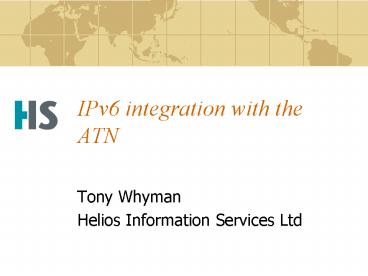IPv6 integration with the ATN - PowerPoint PPT Presentation
1 / 19
Title:
IPv6 integration with the ATN
Description:
... able to co-exist with airborne ADN IP systems Long Term Strategy needed Otherwise issue will keep reappearing IP vs OSI Internet ... with airborne ADN IP ... – PowerPoint PPT presentation
Number of Views:40
Avg rating:3.0/5.0
Title: IPv6 integration with the ATN
1
IPv6 integration with the ATN
- Tony Whyman
- Helios Information Services Ltd
2
Current Status
- The ATN SARPs specify the OSI Protocol Suite
- CLNP, TP4, ES-IS, IDRP
- Mandatory for Government Procurements in early
1990s - Aeronautical Industry working with IP protocol
suite - For Airline Passenger Services
- Possibly some Operational Services
- AEEC Project 664 Aircraft Data Networks (ADN)
3
What is the Issue?
- OSI Standards no longer being developed
- IP Ground Networks cheap and available
- APC Services to use IP Protocols
- IPv6 becoming available
- Considerable Industry investment in the ATN
Specification
4
Need for Change
- ATN must accommodate ground IP networks
- X.25 ceasing to be supported
- IPv4 in short term
- IPv6 in medium to long term
- ATN should be able to co-exist with airborne ADN
IP systems - Long Term Strategy needed
- Otherwise issue will keep reappearing
5
IP vs OSI
- Internet Protocol (IP)
- Transmission Control Protocol (TCP)
- User Datagram Protocol (UDP)
- Routing Protocols
- ARP, RIP, OSPF, BGP-4
- Addressing
- Interface based
- 4 byte addresses (IPv4)
- 16 byte addresses (IPv6)
- Connectionless Network Protocol (CLNP)
- Transport Protocol (TP4)
- Connectionless Transport Protocol (CLTP)
- Routing Protocols
- ES-IS, IS-IS, IDRP
- Addressing
- 20 byte System Addresses
6
Key Differences
- Protocols are not mutually intelligible
- Information is encoded differently
- CLNP has a much bigger address space
- Transport connection semantics are different
- TCP has a graceful release option
- TP4 is both message and stream oriented
7
Options for Convergence (1)
- Replace OSI ATN with IP ATN
- Community investment lost
- Delays introduction of datalink services
- Invalidates current operational services
- Use IP as an ATN Subnetwork
- Ground Only at present
- An Encapsulation Strategy (CLNP inside of IP)
- Permits use of IP Networks as part of ATN
- Does not affect existing Avionics
- Or Ground End Systems
8
Options for Convergence (2)
- IP to CLNP Protocol Conversion
- Permits a gradual replacement of CLNP with IP
- Independent of end-to-end communications (implies
TP4 over IP) - Full migration requires Application Change
- Transport Relays
- TCP to TP4 not possible in general
- ATN Dialogue Service TCP/TP4 gateway possible
- Single Point of Failure Issues
9
The Ground Environment
CLNP
CLNP in End System
ATC Centre
10
The IP SNDCF
CLNP
ES-IS
Other IP Service Users e.g. TCP/UDP
IP SNDCF
Other SNDCFs
IP Network
Data Link Services e.g. Ethernet, PPP, etc.
11
IP SNDCF Benefits
- Simple to implement
- Can support both IPv4 and IPv6
- No impact on rest of ATN
- Allows COTS IP Networks to be part of the ATN
- Gives maximum benefit for least investment
- Specification being presented to ATNP
- Eurocontrol and STNA validating specification
12
Air/Ground Environment
- Expensively produced avionics
- DO178B Level C Software Development
- Certified for Operational Use
- Long in service lifetime
- Support for Aircraft Mobility needed
- Security Requirements Include
- Separation from Passenger Systems
- Resistent to external threats
13
Mobility Scenarios
- Aircraft only uses a single A/G Service Provider
- No network roaming requirement
- Aircraft serially uses multiple A/G Service
Providers - Strategy Required to manage transition
- Aircraft concurrently uses multiple A/G Service
Providers - Strategy required to manage use and route traffic
according to policy and application requirements
14
Current ATN Mobility
- Extends standard Routing Protocols
- Adds information on route QoS and A/G networks
- Meets all Scenarios
- Needs a big address space - mobility at top of
addressing hierarchy - Security
- Leverages off existing web of trust routing
model
15
Mobile IP
16
Mobile IP and ATN
- Supports only serial use of multiple A/G Service
Providers - Security
- Complex dynamic three way trust model
- Requires a network wide Public Key Infrastructure
- Potential for single point of failure
- Rejected by ATNP as a model for ATN Mobility
17
Airborne Convergence Options (1)
- No Change
- Retains strong separation between ATC and
passenger communications - Compatible with use of IP Ground Networks
- Make use of ADN IP networks where appropriate
- Extend use of IP SNDCF
- Respects differences in equipment lifecycles
- Firewalls can maintain strong separation
18
Airborne Convergence Options (2)
- Replace CLNP with IPv6 in new systems
- Requires new SARPs development
- Assumes Ground Systems Migration
- Translation of ATN Mobile Routing to IP
- Requires development of new certified systems
- Requires more complex firewalls
- Compatibility with passenger systems potentially
limited by product lifecycle differences - Currently not under consideration
19
Conclusion
- ATN will include IP Networks in its scope
- IP SNDCF is first step
- Meets most of the real requirement
- Co-existence with ADN IP Systems
- Currently under consideration
- Long Term Strategy to follow































